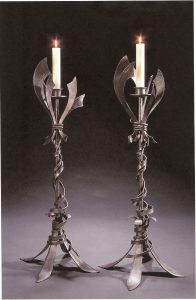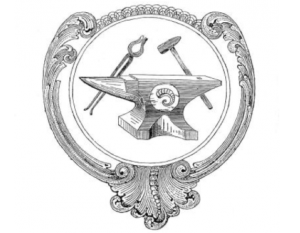New Forms From the Forge
After many years of producing decorative and architectural ironwork reflecting classic designs, I have more recently had the opportunity to express myself in designs that reflect more of the plasticity of the metal. Guided by my blacksmith instincts, the resulting forms are based on what I have learned over the years, simply expressed in a different manner.
The boldness of iron coupled with a graceful fluidity of movement is captivating for me. The allure is the unexpected, and also the unknowns. In the case of the “Port Washington Gate”, the design was preconceived. However preconceived, the design had to evolve from two dimensions (the drawing), to three. Herein lies the excitement, as the adventure of conceiving new forms continues the journey.

The “Candlesticks” were also preconceived, however the ribbons flowing around the center shaft took on a life of their own.

Each new element adds new excitement to the process.
These images, and many others, were shot by George Lottermoser. See more of George’s brilliant work at www.imagist.com.
…….Dan Nauman

3 comments to “New Forms From the Forge”
George - September 11, 2009
Kudos! Dan. Looking forward to many informative posts to come.
Robin Farrell - September 17, 2009
I am extremely impressed at how a material a unwielding as iron can be made to be so organic. It seems to have grown itself, such as a tree would. I’ve been teaching Art on the High School Level for 14 years and can definately use this website in my curriculum. Your artist statement is worded well and this also can be a useful teaching tool. Thanks!
bighornforge - September 18, 2009
Hi Robin,
I would be very interested in the reactions, comments, or ideas that your students have regarding ironwork. Your students may be interested in the fact that iron can be much like clay when hot, and blacksmiths often use clay to model their ideas in iron.
One thing you may wish to consider is having a smith provide a demo for your students, or for that matter, your school. The experience brings many aspects of art into play, as well as art and architectural history.
…….Dan Nauman